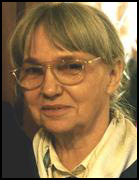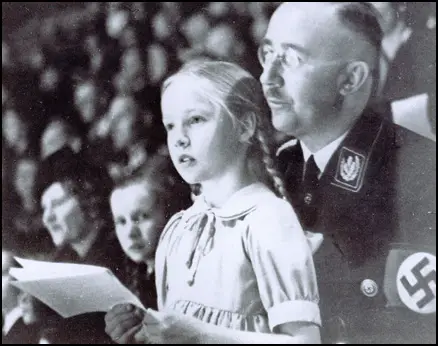Gudrun Himmler

Gudrun Himmler, the daughter of Heinrich Himmler and Margarete Himmler, was born on 8th August, 1929. She was named after a character in a novel written by Himmler's favourite writer, Werner Jansen. Her father was head of the Schutzstaffel (SS) and a close friend of Adolf Hitler, the leader of the National Socialist German Workers Party (NSDAP).
In 1932 Himmler sold the house and poultry farm in Waldtrudering and moved into a flat close to Hitler's apartment. He also purchased a large villa at Gmund on the Tegernsee, a lake south-east of Munich enclosed by mountains. Marga Himmler established herself there with Gudrun, whom they called "Puppi". The following year they adopted a boy named Gerhard von Ahe. He was the son of Kurt von der Ahe, a senior figure in the SS, who had been killed in Berlin in 1933.
Peter Padfield, the author of Himmler: Reichsfuhrer S.S. (1991) has claimed that Himmler was jealous that the two men under him in the Schutzstaffel (SS), Reinhard Heydrich and Karl Wolff, both had attractive wives. Himmler spent very little time with his wife. Lina Heydrich suggested that Himmler was embarrassed by her appearance: "Size 50 knickers, that's all there was to her." Bella Fromm, a journalist commented in July 1937 she saw Himmler with his "dirty-blonde, insipid, fat wife" and "the pleasures of the table are apparently about the pleasures she gets, since Himmler keeps her at home."
In 1939 Heinrich Himmler began an affair with his young secretary, Hedwig Potthast. The couple set up home in Mecklenburg. Hedwig gave birth to a son, Helge (born 1942) and a daughter, Nanette Dorothea (born 1944). Although separated from his wife, Himmler remained close to his daughter, Gudrun, who he phoned every few days and wrote to her at least once a week. Himmler adored his young, blue-eyed, blonde-haired daughter and would often take her to official state functions. In 1941 he even took her to visit the Dachau Concentration Camp.
Gudrun wrote in her diary: "Today, we went to the SS concentration camp at Dachau. We saw everything we could. We saw the gardening work. We saw the pear trees. We saw all the pictures painted by the prisoners. Marvelous. And afterwards we had a lot to eat. It was very nice." According to Stephan Lebert, the author of My Father' s Keeper: Children of Nazi Leaders - An Intimate History of Damage and Denial (2001): "At fourteen... she cut out every picture of him from the newspapers and glued them into a large scrapbook"

In April 1945 Gundrun and her mother were taken into custody. She later complained that they were held in various camps and were "treated as though they had to atone for the alleged sins of her father". They were forced to testify at the Nuremberg Trials and eventually released in November 1946. Gundrun believes that her father did not commit suicide but was murdered by the British. This is a view that is argued by Hugh Thomas in his book, The Unlikely Death of Heinrich Himmler (2001). In 1951 Gudrun also helped form Wiking-Jugend, an organization patterned on the Hitler Youth program of the 1930s.
Gudrun Himmler married the journalist and author Wulf Dieter Burwitz and had two children. She also became a member of Stille Hilfe (Silent Help), an organization providing support to arrested, condemned or fugitive former SS-members. According to journalist Andrea Roepke: “The Silent Help is not only about former National Socialists. It collects money, too, for the neo-Nazi movement.”
Over the years she has given help to people like Anton Malloth, a supervisor of Theresienstadt. She arranged his stay at an expensive nursing home in Pullach, until he was sentenced to life in prison. She also provided help to Klaas Carel Faber, a convicted Dutch Nazi. Gudrun retains her father's fascist views and has been described by Oliver Schröm as a "flamboyant Nazi princess".
In a 1999 interview Gudrun Burwitz gave to Stephan Lebert she talked about trying to save enough money to go to America and examine the evidence that would help her compare her childhood memories with the documents stating her father's views, and the orders he gave. Ultimately, her goal is to write a book called "simply Heinrich Himmler... to clear her father' s name".
The Daily Mail has claimed that "Mrs Burwitz... still works at a ruthless pace to keep the Nazi flame alive. Mrs Burwitz has always nurtured the memory of her father, believing the man who ran the Gestapo, the SS and the extermination programme which murdered six million Jews, to be good and worthy." The newspaper has described her as the "grandmother to a new breed of female Nazis on the radical right".
In 2011 she was reported to be helping in the campaign to prevent Søren Kam, a Danish SS officer wanted in his homeland for several murders, including the execution of newspaper editor Carl Henrik Clemmensen in Copenhagen from being sent back to Denmark.
Gudrun Burwitz lives with her husband in the Munich suburb of Furstenried.
Primary Sources
(1) Peter Padfield, Himmler: Reichsfuhrer S.S. (1991)
Himmler did not manage to steal many days away from his desk at field headquarters or while attending the Fuhrer, but he now divided his family time between two homes, and wrote letters to make up for his absences. He remained a good father to Gudrun and a considerate husband to Marga.
(2) Allan Hall, The Daily Mail (17th June, 2011)
Waving goodbye to her grandchildren, Gudrun Burwitz has the look of a woman ready to live the rest of her days in peace and quiet.
Instead, the 81-year-old daughter of Heinrich Himmler still works at a ruthless pace to keep the Nazi flame alive.
Mrs Burwitz has always nurtured the memory of her father, believing the man who ran the Gestapo, the SS and the extermination programme which murdered six million Jews, to be good and worthy.
And despite her advanced years, she continues to help the ageing remnants of the Nazi regime to evade justice.
As the leading figure in the shadowy and sinister support group Stille Hilfe - Silent Help - she helps bring succour and financial help to those still at large.
Said to have been formed in 1951 by a clique of high-ranking SS officers and right-wing clergy in Germany, it exists ‘to provide quiet but active assistance to those who lost their freedom during or after the war by capture, internment or similar circumstance and who need help to this day’.
Now it is in the hands of Mrs Burwitz. And her work has taken an even more sinister turn. She has become ‘grandmother’ to a new breed of female Nazis on the radical right.
(3) The Daily Mirror (1st December, 2010)
Members of a charity group loyally devoted to helping their old friends met in secret last weekend.
They arrived in ones and twos at the nicely painted house with a well-tended lawn - ever on the look-out for any hidden observer who may have threatened their anonymity.
In most countries they would have passed for modest do-gooders anxious to conduct their benevolent work out of the public gaze.
But there is nothing humanitarian about this shadowy organisation or the kindly looking old lady at the heart of its dark web.
For the covert gathering was the quarterly meeting of Stille Hilfe - or Silent Aid - which has helped some of the Third Reich's most evil fugitives from justice.
And one of its most revered and terrifying figures is the 81-year-old daughter of Heinrich Himmler, architect of the Holocaust. Mother-of-two Gudrun Himmler, known as the Princess of Stille Hilfe, joined other confederates of the Nazi aid group at its weekend summit in Munich.
During her childhood she worshipped her father, who organised the murder of six million Jews in the Second World War, and was worshipped in return.
As head of the Gestapo, he would have her flown to join him wherever he was on his mission to enslave the world. One of her visits was to Dachau, north of Munich, which served as the model for all of Nazi Germany's other concentration camps.
The young Gudrun strolled around with her adoring father and his servants while yards away prisoners were beaten, starved, killed and burned in the camp crematorium.
Such experiences were to defile her innocence for ever. For in keeping the flame of her father's memory alive, she is devoting her last years to nothing more than a support group for mass murderers.
